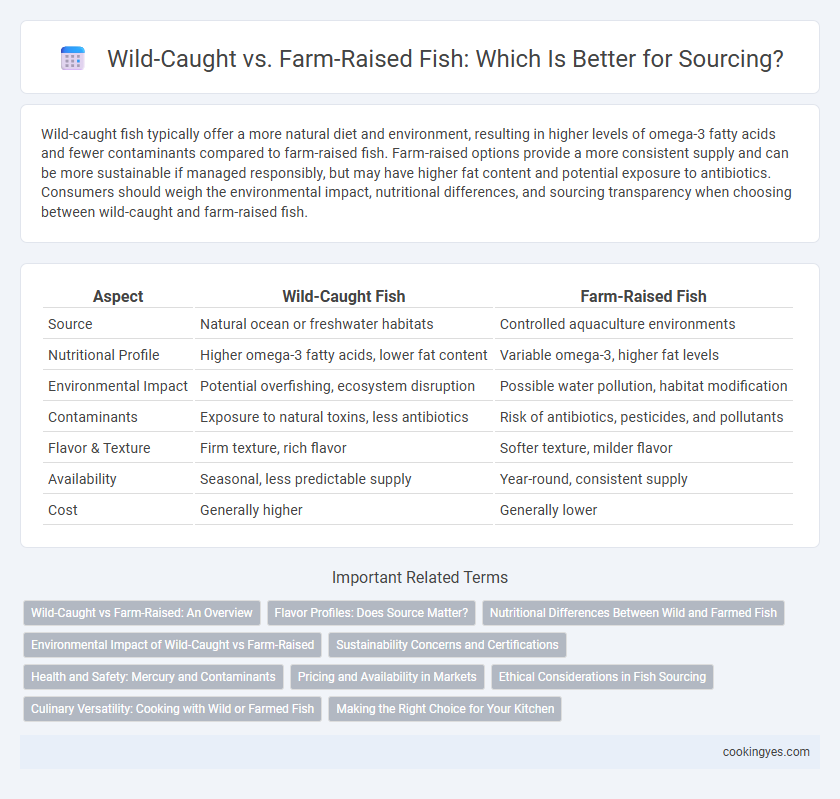Wild-caught fish typically offer a more natural diet and environment, resulting in higher levels of omega-3 fatty acids and fewer contaminants compared to farm-raised fish. Farm-raised options provide a more consistent supply and can be more sustainable if managed responsibly, but may have higher fat content and potential exposure to antibiotics. Consumers should weigh the environmental impact, nutritional differences, and sourcing transparency when choosing between wild-caught and farm-raised fish.
Table of Comparison
| Aspect | Wild-Caught Fish | Farm-Raised Fish |
|---|---|---|
| Source | Natural ocean or freshwater habitats | Controlled aquaculture environments |
| Nutritional Profile | Higher omega-3 fatty acids, lower fat content | Variable omega-3, higher fat levels |
| Environmental Impact | Potential overfishing, ecosystem disruption | Possible water pollution, habitat modification |
| Contaminants | Exposure to natural toxins, less antibiotics | Risk of antibiotics, pesticides, and pollutants |
| Flavor & Texture | Firm texture, rich flavor | Softer texture, milder flavor |
| Availability | Seasonal, less predictable supply | Year-round, consistent supply |
| Cost | Generally higher | Generally lower |
Wild-Caught vs Farm-Raised: An Overview
Wild-caught fish are harvested directly from natural water bodies, providing a diverse nutrient profile due to their natural diet and environment, while farm-raised fish are cultivated in controlled aquaculture systems, allowing for consistent supply and size. Wild-caught options often contain higher levels of omega-3 fatty acids and fewer contaminants compared to some farm-raised varieties, which may be exposed to antibiotics and artificial feeds. Understanding the differences in sourcing helps consumers make informed decisions based on health benefits, environmental impact, and sustainability of fish products.
Flavor Profiles: Does Source Matter?
Wild-caught fish often exhibit a more complex and robust flavor profile due to their natural diet and diverse habitats, which enhance the umami and mineral notes. Farm-raised fish, while milder and sometimes fattier, offer consistent texture and taste owing to controlled feeding and environment. Flavor preferences vary, but sourcing impacts the sensory experience significantly, influencing culinary applications and consumer choice.
Nutritional Differences Between Wild and Farmed Fish
Wild-caught fish generally contain higher levels of omega-3 fatty acids and essential nutrients such as vitamin D and selenium compared to farm-raised fish. Farmed fish often have increased fat content but may exhibit lower concentrations of beneficial polyunsaturated fats due to controlled diets and environments. Differences in nutrient profiles directly impact the overall health benefits, with wild fish typically offering a more balanced and nutrient-dense option.
Environmental Impact of Wild-Caught vs Farm-Raised
Wild-caught fish harvesting can disrupt marine ecosystems and deplete fish populations, leading to biodiversity loss and habitat damage. Farm-raised fish reduce pressure on wild stocks but may cause water pollution and spread diseases in surrounding waters if not properly managed. Sustainable practices in both methods are essential to minimize environmental impacts and ensure long-term aquatic ecosystem health.
Sustainability Concerns and Certifications
Wild-caught fish often face sustainability concerns due to overfishing, bycatch, and habitat destruction, which threaten marine ecosystems and biodiversity. Farm-raised fish provide a controlled alternative but can raise issues related to water pollution, antibiotic use, and genetic diversity loss if not properly managed. Certifications such as the Marine Stewardship Council (MSC) for wild-caught and the Aquaculture Stewardship Council (ASC) for farm-raised fish help ensure sustainable practices by setting environmental and social standards.
Health and Safety: Mercury and Contaminants
Wild-caught fish generally contain lower levels of contaminants such as mercury and industrial pollutants compared to some farm-raised fish, which may accumulate toxins due to concentrated feeding practices. Farm-raised fish pose risks related to antibiotics and pesticides used in aquaculture that can affect human health. Choosing sustainably sourced wild-caught fish supports reduced exposure to harmful substances and promotes safer seafood consumption.
Pricing and Availability in Markets
Wild-caught fish generally command higher prices due to limited supply and seasonal availability, reflecting the costs of sustainable harvesting and environmental impacts. Farm-raised fish offer more consistent availability year-round and lower prices, benefiting from controlled breeding and feeding practices. Market demand and regional preferences further influence pricing disparities between wild-caught and farm-raised seafood.
Ethical Considerations in Fish Sourcing
Sourcing wild-caught fish often raises ethical concerns related to overfishing, habitat destruction, and bycatch affecting marine biodiversity and ecosystem balance. Farm-raised fish can offer a more controlled environment aiming to reduce pressure on wild populations, but may involve challenges such as pollution, disease transmission, and the use of antibiotics. Evaluating ethical considerations in fish sourcing requires a balance between sustainability, animal welfare, and the long-term health of aquatic ecosystems.
Culinary Versatility: Cooking with Wild or Farmed Fish
Wild-caught fish offers a diverse range of flavors and firmer textures that enhance grilling, searing, and poaching methods commonly used in gourmet cuisine. Farm-raised fish provides consistent quality and milder taste, ideal for baking, steaming, and frying techniques that benefit from uniform fat content and size. Understanding these culinary differences helps chefs select the best fish type to optimize flavor profiles and cooking outcomes in various recipes.
Making the Right Choice for Your Kitchen
Choosing between wild-caught and farm-raised fish depends on factors like sustainability, flavor, and nutritional value. Wild-caught fish often offer a richer taste and higher Omega-3 content, while farm-raised fish provide a consistent supply and lower environmental impact if sourced responsibly. Evaluating certifications such as MSC for wild-caught or ASC for farm-raised can guide a responsible and informed decision for your kitchen.
Wild-caught vs Farm-raised for sourcing Infographic

 cookingyes.com
cookingyes.com